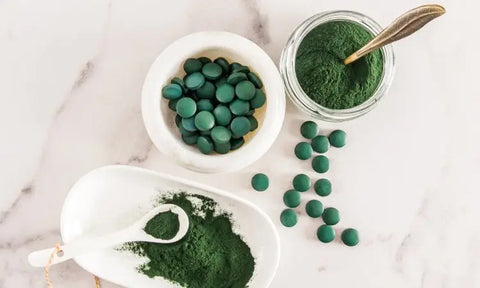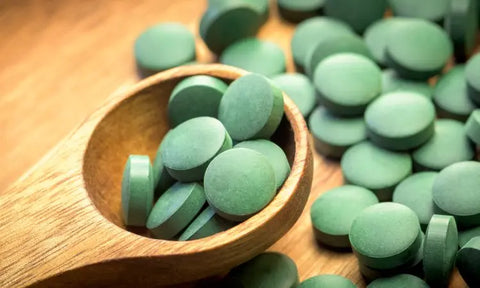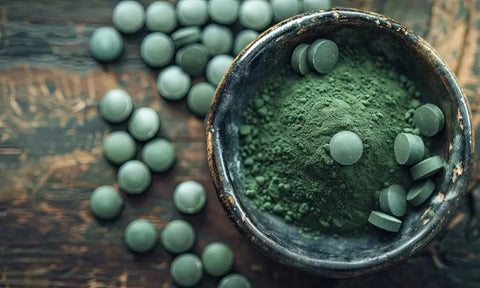Spirulina has always intrigued us with its exceptional nutritional values and its health benefits. But did you know that behind this little blue-green algae lies a fascinating story dating back billions of years? It is precisely on the origin of spirulina and its various historical uses which we will look at in this article.
The history of spirulina dates back to ancient civilizations such as the Aztecs and Kanembou to the modern era. Many organizations, including the UN and WHO have expressed interest in its health benefits.
To better understand the origin of spirulina and its place among the most coveted superfoods, we will explore:
- The history of spirulina among ancient peoples
- The scientific side of blue-green algae
- The recognition of this super algae by renowned organizations
- The importance of its place of production
Explore with us the origins and the history of spirulina production , from ancient times to today. Let’s discover together how this blue-green algae has become one of the most sought-after food supplements in the world. Keep reading!

The historical origin of spirulina
Spirulina, this precious microalgae with remarkable nutritional virtues, has a history that goes deep into ancient times. It finds its origin in the early ages of life on Earth, a long time ago. 3.5 billion years .
This super algae was known and used by primitive civilizations who populated regions as diverse as South America and Africa. The indigenous peoples of these regions had incorporated it as an essential part of their diet. Let's take a closer look the history of spirulina through its use during these ancient times.
Spirulina, an ancestral discovery from the Aztecs
The first reliable historical accounts of these superfoods come from the Spanish conquistadors, including Hernán Cortés. He claims to have discovered a green dish, prepared in the form of a pie, during the conquest of the Aztecs by the Spanish .
In fact, between the 14th and 16th centuries, the Aztec civilization widely used this spiral algae, which they called " Tecuitlatl " Harvested in Lake Texcoco, where it proliferates naturally, this microalgae was an essential food source for the Aztecs.
Once harvested, the blue-green algae was dried in the sun and then cut into bricks. This method of preservation provided the Aztecs with a vital source of protein throughout the year. Although their shape differs from the organic spirulina tablets that we consume today, these cakes provide the same nutritional benefits.

The Kanembou origin of spirulina
Spirulina has an even older history in Chad , in the Kanem region.The Kanembou exploit its nutritional resources since time immemorial. They harvest the super algae from the surface of the lakes. These lakes are home to a kind of “green mush” that grows naturally in these mineral-rich waters.
After harvesting, the spirulina is dried to be transformed into cakes, called “ dihe » in the Kanembou tradition. These pancakes are an important source of nutrients for the community. These microalgae are also used to prepare nutritious broths that enrich meals. These products are also sold in local markets , allowing residents to benefit from this precious source of nutrition.
If you want to deepen your knowledge on the food spirulina , this article can tell you more.
The first notable scientific observations of the super algae
Spirulina has been the subject of an important scientific discovery in the 1960s , thanks to the work of the pioneer Jean Léonard. During a expedition to Chad , he identified this microalgae and gave it the name Spirulina platensis. This discovery marked the beginning of the modern study of this super algae.
At the beginning of the 1970s , the IFP (French Petroleum Institute) asked the company SOSA-TEXCOCO for permission to study this blue-green algae. Dr. Clément was particularly interested in the many nutritional benefits of spirulina, including its high protein content. This protein research drew the attention of the scientific world to this microalgae. Studies on Spirulina have shown that it could become a potential food source and have attracted growing interest.
This craze marks the history of spirulina production on a large scale in the late 1970s. This event marks a major turning point for this superfood, which has gone from a scientific discovery to a global nutritional asset.
The scientific aspect of spiral algae
Spirulina, this super algae with remarkable nutritional virtues, takes its name from its fascinating scientific aspect. In Latin, the term " spirulina » means a spiral or twist, in keeping with the unique structure of this microalgae. It gets its name from the way its cells are twisted into a corkscrew shape. Spirulina is generally between 0.3 and 0.5 mm long , which makes it visible only under a microscope. Despite its small size, it is extremely rich in essential nutrients.

There are many species of spirulina found in aquatic and marine ecosystems around the world. However, only three species of spiral algae have been extensively studied. These super algae are both edible and have exceptional nutritional qualities .These include:
- Arthrospira maxima
- Arthrospira platensis
- Arthrospira fusiformis
Spirulina and its history with renowned organizations
Spirulina is widely recognized as a superfood due to its exceptional health benefits. Since 1974, the UN has entered the history of spirulina production by supporting this microalgae. The United Nations has even called it " best food of the future " This led to the creation of the Intergovernmental Institute for the Use of Super Algae against Malnutrition. Here is also Top 5 Health Benefits of Spirulina , to give you an overview of its benefits.
Its various health benefits have earned spirulina a recognition by WHO in 2005 . The latter describes it in particular as the main means of combating famine and malnutrition for the populations. Even the NASA has shown interest in this superfood for its space missions. Its exceptional nutritional values make it an asset for long-duration manned flights.
Nowadays, Spirulina and its benefits are unanimous in the field of food supplements. This blue-green algae is very beneficial for the body because of the many nutrients it contains. But What is the composition of spirulina? If you're interested in what makes up this superfood, check out our article on the subject.
Its consumption has even been authorized in the context of the Olympic Games . Indeed, the high protein content of this food supplement helps support sports performance. Its low cholesterol level is also beneficial for athletes.
To provide additional support to athletes, we have created our Spirulina Elixir . Besides the large amount of nutrients it contains, this elixir is easily assimilated by the body .

The main environmental challenges related to the cultivation of microalgae
Spirulina has special culture characteristics which means that it is not found in just any fresh water. Let’s take a closer look at the specific issues related to the cultivation of this microalgae.
The ideal growing conditions for creating spirulina
Blue-green algae requires a growing environment and a very specific water quality , especially in terms of pH. The latter must be precisely controlled, often maintained between 9 and 11. This super algae thrives in brackish salinity environments Spirulina cultivation also requires optimal temperatures, generally around 35 to 37°C.
This microalgae has the particularity of develop depending on the nutrients present in the basins where it is grown. This specificity allows the spiral algae to be enriched with a specific nutrient in order to create a spirulina with very specific properties. This is how we obtain our iron enriched spirulina , zinc, etc.
Place of cultivation and origin of this thousand-year-old superfood
Blue-green algae must be grown in a pure environment to keep intact all its beneficial properties for health. This means that the place where spirulina is grown must be free of pollution that could alter its quality.
This is why at Algorigin we cultivate our Spirulina at the foot of the Andes Mountains in Ecuador . This region benefits from a preserved environment, clean air and water from the melting snow of the Cayambe volcano. The region benefits from sunshine and temperatures conducive to the successful cultivation of spirulina.
It is this exceptional natural setting that makes our 100% natural spirulina , safe and highly prized. The environmental purity is reflected in that of our superfoods, offering you superior quality products. Get the best food supplements with complete peace of mind in our store. Whether you choose our organic spirulina in granules or in tablets, you can be sure of the quality of the product.

Spirulina, a food supplement rich in history
We have seen that over the centuries, spirulina has witnessed multiple evolutions. It has gone from exploitation by ancient civilizations to recent scientific discoveries that have revealed its full potential. Its scientific discovery has also allowed its integration into programs to combat malnutrition worldwide.
Beyond its thousand-year-old history, the super algae also draws its nutritional richness from its place of cultivation. It is to guarantee this richness and purity that we have set up our farm at the foot of the Andes. This allows us to produce spirulina at the same time rich in nutrients and 100% organic . So, choose the range of spirulina that suits you in our store and benefit from its exceptional benefits for your health.




